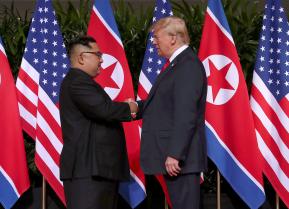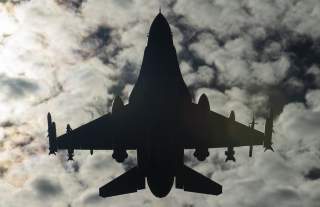This Is the Airpower Theorist the Air Force Needs (And Already Has)
There is no need to borrow from seapower theory to think soundly about airpower theory.
If one’s main text on airpower is Douhet’s Command of the Air, as it appears to be at the Naval War College, then it is no wonder that one feels the need to call for a Corbett of airpower.
James Holmes recently argued that airpower needs a theorist with the heft of Clausewitz. This, he insists, would help us to steer clear of tiresome, never-ending debates about whether the Air Force needs to invest more in A-10s, F-35s, or light-attack aircraft.
Perhaps Holmes correctly suggests that these debates on the blogosphere have been overdone. Yet he frames his entire article in this same tired discussion. And he is flat out wrong that Douhet is still the “best available guide to air-power theory.” He omits an entire body of airpower theory from his discussion in arguing that no extant author can help aviators “debate how best to configure air forces and deploy them for tactical, operational, and strategic gain.” Relevant names to add to this discussion include John Slessor, John Warden, and John Boyd, to name a few.
A less known airpower theorist, however, holds even more relevance to the kind of discussion Holmes seeks. Back in 2012, Air University commissioned and published Colin Gray’s Airpower for Strategic Effect, which opens up the aperture on airpower thinking. Some might suggest that Air University’s sponsorship of the work represents a desperate attempt to legitimize the Air Force’s existence. But to dismiss the work outright would be to fail to appreciate how much it represents a departure from traditional Air Force thinking. This can be seen in the way that Gray takes on two of the Air Force’s most prominent airpower advocates who tend toward the more zealous, namely Philip Meilinger and Richard Hallion.
Gray—whom some consider to be one of the world’s foremost strategic thinkers—wrote in his work in the context of the ongoing insurgency during Operation Iraqi Freedom. At first, airpower performed brilliantly in a combined air-ground campaign that in many ways hearkened back to World War I, the first time that airpower was used in great power conflict. But this soon dissolved into years of close air support in support of an insurgency that had many asking, to what end?
What Gray critically sought to delineate was the nature of airpower, no easy task. Indeed, much airpower theory has reflected the ever-shifting character of war. To do so, Gray drew on his grounding in Clausewitzian thinking, so much so that he provided twenty-seven dictum, or one less point than those outlined in the master’s essential Book 1 of On War, perhaps in an attempt at humility.
To read Gray’s twenty-seven dictum today is not to receive something akin to manna from a pallet dropped by a C-130 if one is conversant in airpower. In other words, many airmen will agree with much of what Gray says because it represents sound thinking about airpower. Gray’s discussion encapsulates how airpower thinking has evolved, particularly since 1999, the Air Force’s last gasp of strategic airpower. Gray might fail at representing the nature of airpower in something as neatly digestible as Clausewitz—namely that it is violent, political, and “interactive”—what he does provide a comprehensive yet nuanced discussion of airpower’s timeless attributes
Of his twenty-seven dictum, a handful are of particular importance. First, solid airpower theory serves to inoculate practitioners from flights of fancy and the latest fads. In other words, it provides the essential “perspective of a longue duree.” Of all the services, the Air Force has long seen itself as forward leaning and not limited by pesky traditions. It is the greyhound first out of the gates, in hot pursuit of the rabbit. Gray cautions the Air Force to take a deep breath and be sure its choices are grounded in airpower’s demonstrated nature. Indeed, setting aside the generations of aircraft that have come and gone and the other massive technological developments, there is much that remains the same. The Air Force’s institutional choices and preferences have sometimes masked that reality, though.
Gray also sets out the capabilities and limitations of airpower that are essential for considering what airpower can do well and what it cannot do so well. For example, Gray provides eighteen digestible bullet points, including that airpower ably “project[s] force rapidly and globally” but that it cannot “seize and hold contested territory.” This provides a starting point for discussing how airpower can meet objectives at the tactical, operational, and strategic levels of war, as Holmes wants.
In regard to Holmes’ assertion that strategic bombing continues to be a “glamour” mission for the Air Force, Gray weighs in helpfully on the contentious debate over whether airpower can “go it alone” and win wars. He insists that situations enabling such victories are “rare,” in part because airpower can set the conditions for victory but only if the ground follows up. Even then, though, Gray argues that there is no such thing as “strategic” airpower as determined by platform or mission, for all military action is tactical “in the doing.” A B-52 carrying a nuclear weapon, then, is not engaged in a strategic mission. It might have what Gray calls strategic effect, but only if one’s adversary judges it to have that effect. Gray’s contention that even helicopters can “do strategy” similarly keeps the reader grounded in a holistic appreciation for the range of what airpower can do. In effect, it helps to “collapse the silos separating communities within the U.S. Air Force” at which Holmes aims.
Similarly, Gray takes on the primary airpower text used by Holmes and others at the Naval War College in arguing that air strategy is about far more than targeting. In effect, Douhet was “wrong.” Yet he shies away from incorporating cyberspace and space into his discussion. In doing so, he offers yet another challenge to the Air Force. It defines Airpower as the “ability to project military power . . . through the control and exploitation of air, space, and cyberspace.” Again, this reinforces the contention that he is no stooge to the Air Force
Like the best theory, Gray’s twenty-seven dictum are hardly prescriptive. As such, they leave readers looking for easy answers unsatisfied. But they provide a starting point for thinking about airpower in the broadest ways, both historically and conceptually. It is indeed a theory that naval aviators, Air Force officers, international officers, and others can begin wrestling with to consider how best to keep airpower from being grounded in the future fight. In short, there is no need to borrow from seapower theory to think soundly about airpower theory as Holmes suggests. The book is in the mail.
Dr. Heather Venable is an assistant professor of military and security studies at the Air Command and Staff College where she teaches airpower. Her research interests include organizational culture, the Marine Corps, and airpower. The views expressed in this article are those of the author and do not necessarily reflect the official policy or position of the Air Force, the Department of Defense, or the U.S. Government.


